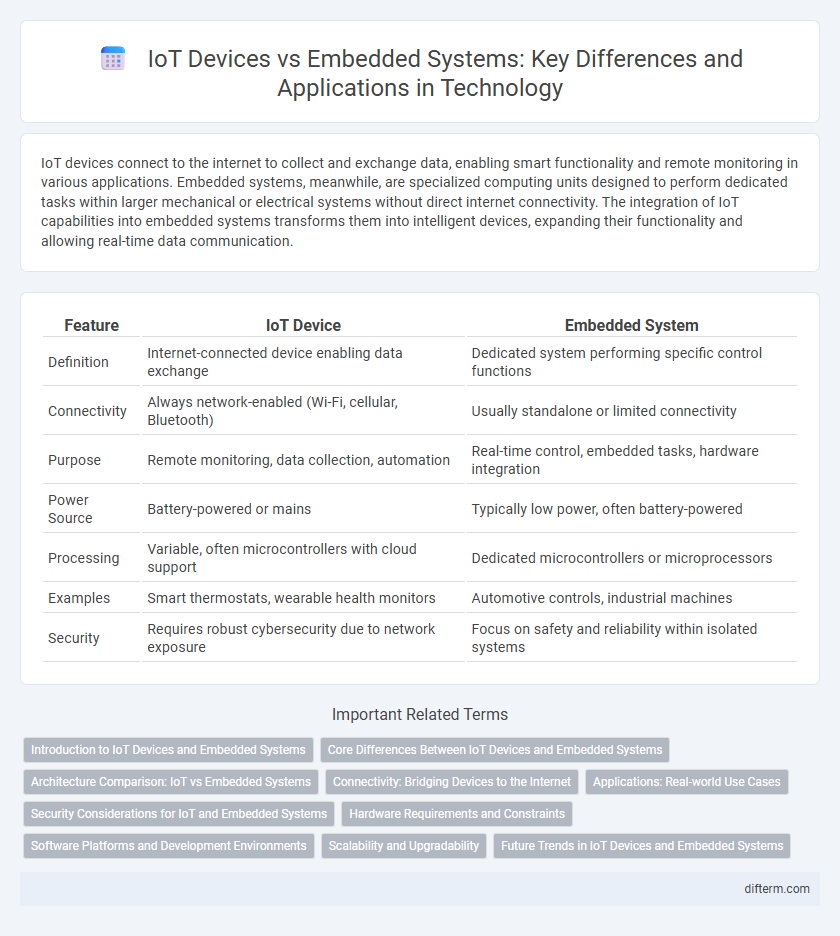IoT devices connect to the internet to collect and exchange data, enabling smart functionality and remote monitoring in various applications. Embedded systems, meanwhile, are specialized computing units designed to perform dedicated tasks within larger mechanical or electrical systems without direct internet connectivity. The integration of IoT capabilities into embedded systems transforms them into intelligent devices, expanding their functionality and allowing real-time data communication.
Table of Comparison
| Feature | IoT Device | Embedded System |
|---|---|---|
| Definition | Internet-connected device enabling data exchange | Dedicated system performing specific control functions |
| Connectivity | Always network-enabled (Wi-Fi, cellular, Bluetooth) | Usually standalone or limited connectivity |
| Purpose | Remote monitoring, data collection, automation | Real-time control, embedded tasks, hardware integration |
| Power Source | Battery-powered or mains | Typically low power, often battery-powered |
| Processing | Variable, often microcontrollers with cloud support | Dedicated microcontrollers or microprocessors |
| Examples | Smart thermostats, wearable health monitors | Automotive controls, industrial machines |
| Security | Requires robust cybersecurity due to network exposure | Focus on safety and reliability within isolated systems |
Introduction to IoT Devices and Embedded Systems
IoT devices are interconnected objects equipped with sensors and software to collect and exchange data over the internet, enabling smart environments and real-time monitoring. Embedded systems refer to specialized computing units integrated into larger mechanical or electrical systems, designed for dedicated functions with real-time constraints. While IoT devices emphasize connectivity and data communication, embedded systems focus on reliable, efficient control within specific applications.
Core Differences Between IoT Devices and Embedded Systems
IoT devices are interconnected units designed to collect, exchange, and process data over the internet, enabling real-time remote monitoring and control, whereas embedded systems operate as dedicated, self-contained units performing specific functions with limited or no network connectivity. Core differences include communication capabilities--IoT relies on wireless protocols like Wi-Fi, Zigbee, and Bluetooth, while embedded systems often utilize direct hardware interfaces or wired communication. Additionally, IoT devices prioritize cloud integration and data analytics, contrasting with embedded systems' focus on reliability, low latency, and resource-constrained environments.
Architecture Comparison: IoT vs Embedded Systems
IoT devices feature a layered architecture that integrates sensors, connectivity modules, cloud services, and data analytics platforms, enabling real-time data exchange and remote management. Embedded systems rely on tightly-coupled hardware and software components optimized for dedicated functions with minimal or no network connectivity, emphasizing reliability and low power consumption. The key architectural difference lies in IoT's emphasis on networked interoperability and edge-to-cloud data flow, whereas embedded systems focus on standalone control within constrained environments.
Connectivity: Bridging Devices to the Internet
IoT devices are specifically designed with built-in connectivity features such as Wi-Fi, Bluetooth, or cellular modules to enable seamless communication over the internet. Embedded systems may lack native internet connectivity and often rely on external modules or gateways to bridge them to cloud networks. The integration of IoT protocols like MQTT and CoAP in IoT devices enhances real-time data exchange and remote management compared to traditional embedded systems.
Applications: Real-world Use Cases
IoT devices enable smart home automation by connecting appliances like thermostats, lighting, and security systems to the internet for remote control and data analytics. Embedded systems power industrial machinery, automotive controls, and medical devices with dedicated functionality and real-time processing capabilities. In agriculture, IoT sensors monitor soil moisture and weather conditions, while embedded systems manage irrigation equipment and crop health, illustrating distinct but complementary applications.
Security Considerations for IoT and Embedded Systems
IoT devices require advanced security measures such as encrypted communication and real-time threat detection due to their constant network connectivity and exposure to external threats. Embedded systems often rely on hardware-based security features like secure boot and trusted execution environments to protect critical operations and data integrity. Both IoT and embedded systems must implement robust authentication protocols and regular firmware updates to mitigate vulnerabilities and prevent unauthorized access.
Hardware Requirements and Constraints
IoT devices require wireless connectivity modules, low-power processors, and sensors tailored for real-time data collection, emphasizing energy efficiency and seamless integration with cloud platforms. Embedded systems often rely on specialized microcontrollers optimized for specific tasks, with stringent constraints on memory, processing power, and thermal management. Both demand compact, cost-effective hardware, but IoT devices prioritize extended battery life and network compatibility, whereas embedded systems focus on reliability and deterministic performance in controlled environments.
Software Platforms and Development Environments
IoT devices commonly utilize cloud-based software platforms such as AWS IoT, Microsoft Azure IoT Hub, and Google Cloud IoT Core, enabling seamless connectivity, data analytics, and remote device management. Embedded systems typically rely on real-time operating systems (RTOS) like FreeRTOS, VxWorks, or embedded Linux distributions, optimized for low latency and resource constraints in device control. Development environments for IoT emphasize interoperability and scalability using SDKs and APIs, while embedded system development focuses on hardware-level programming with tools like Keil, IAR Embedded Workbench, and platform-specific IDEs.
Scalability and Upgradability
IoT devices offer superior scalability through cloud connectivity, enabling seamless integration of new sensors and functionalities without hardware redesign. Embedded systems often require significant hardware modifications for upgrades, limiting flexibility and increasing costs over time. The cloud-driven architecture of IoT facilitates remote firmware updates, enhancing upgradability compared to the static nature of traditional embedded systems.
Future Trends in IoT Devices and Embedded Systems
Emerging trends in IoT devices emphasize advanced AI integration and edge computing to enhance real-time data processing and autonomy. Embedded systems are evolving with enhanced security protocols and energy-efficient designs to support the expanding IoT ecosystem. The convergence of IoT and embedded technologies drives innovation in smart cities, healthcare, and Industry 4.0 applications, highlighting future scalability and interoperability challenges.
loT device vs embedded system Infographic

 difterm.com
difterm.com